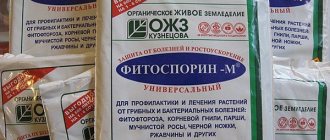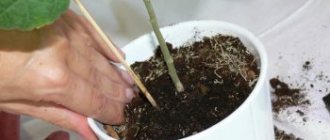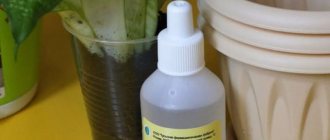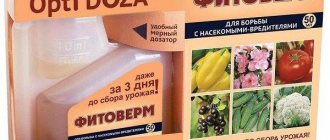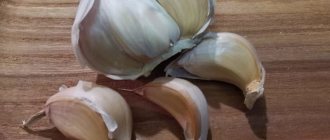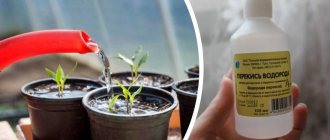Why do indoor plants need phytosporin?
Fitosporin is known to many gardeners for its high efficiency and environmental friendliness. This almost completely safe product contains gram-positive aerobic bacteria, which, accumulating in the soil, help the plant resist various pathogenic pathogens.
The use of Fitosporin also helps indoor flowers adapt to new environmental conditions.
Treatment of plants with Fitosporin allows you to achieve important goals in floriculture.
- Improves nutrient absorption by roots.
- The activity of pests is suppressed.
- The soil becomes healthier, saturated with beneficial bacteria.
- Indoor plants take root better and grow faster.
- Flowers' immunity increases.
Compatibility with other drugs
Most indoor flower care products can be used simultaneously with Fitosporin.
This applies to:
- insecticides;
- antibiotics;
- root formation stimulants;
- fungicides;
- fertilizers;
- growth regulators.
Fitosporin cannot be combined with drugs that can enter into an alkaline reaction with it. This is easy to check; if a precipitate forms when combining the components, stop using this complex. The possibility of using Fitosporin in combination with other products, its affordable price, and high efficiency explain its popularity among gardeners.
Action and properties of the drug
Fitosporin contains the active substance - the bacterium Bacillus subtilis (bacillus subtilis) on a humic carrier. Chalk, saturated with microelements, is used as the main filler of the carrier. The drug contains two strains of bacteria:
- An interstitial (endophytic) strain, penetrating into plant tissue, activates its protective mechanisms. At the same time, the proliferation of pathogenic bacteria is blocked and their cell membrane is destroyed.
- The surface (rhizosphere) strain synthesizes substances that are absorbed by the root system and have a positive effect on plant development.
A living culture of Bacillus subtilis, multiplying in the soil, saturates it with useful substances and suppresses the growth of pathogenic organisms.
Fitosporin has a number of properties that facilitate its use.
- Economical in consumption, a fairly long shelf life without loss of properties allows multiple treatments to be carried out with one solution.
- Due to its versatility and variety of forms, it is widely used in the fight against numerous diseases.
- High level of effectiveness and compatibility with other fungicides.
REFERENCE . Fitosporin is available in convenient volumes and various forms. The price of the product is affordable for most flower growers.
Advantages of using the drug
The product has advantages over other fungicides that are worth paying attention to. Among them are the following:
- The use of Fitosporin is possible throughout the growing season, it is a completely biological preparation, after spraying the plants with it, the fruits from them can be eaten on the day of treatment.
- Simultaneously with suppressing the vital activity of pathogens, Fitosporin strengthens the immunity of plants to the diseases against which it acts, thereby preventing re-infections.
- Bacteria suppress the activity of pathogens both on the plants themselves and in the soil if it has been treated with the drug.
- It has convenient release forms: powder, paste, liquid.
We recommend reading
The use of urea (urea) as a fertilizer in the garden and in the garden
The use of Bordeaux mixture in gardening and in the garden
Instructions for use of the root formation stimulator Kornevin, reviews
How to use chicken manure in the garden, preparing fertilizers
What diseases and pests can Fitosporin-M be used against?
Fitosporin, being a broad-spectrum fungicide, is effective against many diseases of fungal and bacterial nature. It is widely used to protect not only indoor plants, but also those grown in open ground.
The main threat to flowers is caused by pathogens:
- zonal (black) spotting;
- powdery mildew;
- various root rots.
Fitosporin also suppresses the activity of pathogens:
- brown leaf rust;
- scab;
- moniliosis;
- cladosporiosis;
- fusarium;
- late blight.
Having a comprehensive effect on soil quality, the product actively suppresses the activity of pathogenic bacteria.
Consumption rates
The amount of biofungicidal powder and the concentration of its dilution depend on the purpose of use and on the planting crops. First, a working solution (WS) is made. If it is a paste, dilute a 200-gram bag with 2 glasses of water. If there are no specific instructions for a given crop, general recommended standards should be followed. PP is prepared at least 1-2 hours before use.
For soaking seeds, cuttings, bulbs and tubers
Add 2-3 drops of the finished composition to 1 glass of water.
Tubers and bulbous plants are soaked immediately before planting for 2-3 hours. After the procedure, small seeds should be dried until the free-flowing state is restored, otherwise planting them will be difficult and subsequently thickened.
For spraying plants leaf by leaf
For a large (10 liter) bucket of water - 2-3 tsp. This amount is enough to treat 100 sq.m. landing This figure is arbitrary, since it depends on the height of the plants, the degree of their foliage, etc.
For a 10-liter bucket, take 1 tbsp. solution. Distribute over 2 sq.m. beds.
For compost pit
For 1 liter of water add 1 tbsp. working solution. This is enough for about 50 kg of the contents of the compost pit. It is recommended to take “Fitosporin” enriched with “gummy” for this case.
Despite the spread of mineral-based fertilizers, pesticides and fungicides, the effectiveness of the corresponding preparations is still controversial among flower growers: “chemistry,” depending on its purpose, actually enriches the soil, removes diseases and pests, but this does not happen without destroying the natural microflora. As a result, plant care deserves the use of exclusively biological agents, and Fitosporin for flowers is one of these.
Late blight, powdery mildew, blackleg - no matter what ailments the greenhouse is exposed to, the causative agents of the unpleasant scourge are always fungi and bacteria. Accordingly, using a fungicide to control them makes a lot of sense.
On a note
The drug from Ufa has a low toxicity class of 4. The threat to living organisms, including humans, animals and beneficial insects (eg bees, ants), is reduced to a minimum. Poisoning and irritation can only occur if the basic rules for using and storing the product are not followed: you need to handle plants with rubber gloves, and then be sure to wash your hands with soap and hide the biofungicide in a place inaccessible to children and animals
Release forms of Fitosporin-M
Fitosporin is available in convenient packages. For greater efficiency, it is produced in three main varieties:
- In the form of a powder, which has an anhydrous fine structure. The powder can be used to prevent and treat diseases. It does not lose its beneficial properties during long-term storage.
- In the form of a paste in polymer packaging. This preparation is rich in humic substances. Mainly used for prevention and strengthening immunity. Has a long period of action.
- In liquid form, the drug is presented as a highly concentrated solution. It is used for spraying damaged plants.
Methods of using Fitosporin
The drug is popular among summer residents and gardeners. The drug can be used for the following purposes:
- disinfection of soil and seeds;
- treatment of indoor and garden plants against fungal infections;
- spring prevention of seedlings from diseases before planting in the ground;
- acceleration of root formation in ornamental plants;
- as a foliar fertilizer to improve plant immunity;
- for storing bulbs. It is especially often used for apartment conditions when the bulbs are kept warm.
How to dilute Fitosporin for indoor flowers and plants
Before treating indoor flowers with Fitosporin, you must read the instructions. It is important to pay attention to the required concentrations of Fitosporin and its purpose.
How to dilute powder for different colors, instructions
The powder is used in dissolved form. They spray or water flowers with it. Depending on the type of plant, the required concentration of the substance is selected.
| Purpose of application | orchids | violets | succulents | roses |
| Prevention by watering | 2g/1l | 1.5g/1l | 1.5g/l | 2g/1l |
| Prevention by spraying | 1.5/l | 1g/l | 1g/0.5l | 1.5g/1l |
| Treatment | 1.5-2g/l | 2g/l | 2g/l | 2g/0.5l |
How to use liquid form of phytosporin
Phytosporin in liquid form is easy to use. After opening the bottle, the product is diluted with water at room temperature in a ratio of 10 drops per 100 ml and mixed thoroughly. The prepared mixture is sprayed on indoor flowers or root watering is carried out.
Fitosporin in the form of a paste for indoor plants
The product in the form of a paste requires preliminary preparation. First, prepare a concentrated master solution, which can be stored for 4 years. To do this, the required volume of paste is dissolved in water at room temperature in a ratio of 1:2 and left for several hours.
Further dilution is carried out as necessary in accordance with the instructions. The working solution can be stored for up to 6 hours.
Instructions for use
Sticky leaves on indoor plants - causes and control
Having purchased “Fitosporin M”, you need to study the instructions for use for indoor plants. It indicates the dosage of the drug, methods of processing and methods for safe use of the product.
Precautionary measures
If Fitosporin comes into direct contact with mucous membranes, it can cause itching and mild irritation. Therefore, when working with the drug, you must follow the safety rules:
- Wear silicone gloves;
- During the treatment period, it is not allowed to eat, drink or smoke;
- When spraying, use eye protection (goggles) and prevent the product from entering the respiratory tract (wear a respirator or fabric mask). In summer, it is better to take the plant out of the room into the open air (but not in the sun!);
- Do not prepare solutions of the drug in food containers;
- If Fitosporin gets on the skin or mucous membranes, they are thoroughly washed with a stream of water;
- If it gets into the stomach, rinse it, induce vomiting, and take activated carbon tablets;
- After finishing use, wash your hands, face, and neck with soap;
- Store the product in places where access to children and pets is difficult.
How to process correctly
The bacteria-based product can be used for all types of indoor plants, including “Fitosporin” is effective for orchids. The main purposes of using the drug:
Instructions for use on the packaging
- Plant treatment;
- Preventive treatment to prevent the occurrence of diseases;
- Soaking seeds;
- Use for processing cuttings;
- Preparing the soil before planting seeds.
Important! If the plant needs saving because the disease is advanced, then chemical agents are more effective. The initial stages of diseases can be treated with Fitosporin.
You can treat indoor plants by watering the soil and spraying. Watering schedule is monthly. For diseased plants, treatment should be carried out 2-3 times a week.
If “Fitosporin” is used for orchids, then there is a difference in how to use it for watering. The pot with the orchid is immersed in a large container filled with a solution of the drug, and after 15-20 minutes it is pulled out.
When resuscitating orchids, a “Fitosporin” solution is prepared, the roots are immersed in it after washing and trimming dead and rotten parts.
Soaking seeds before planting also has a good effect in preventing diseases.
Important! "Fitosporin" is used in autumn and spring for preventive spraying of plants. Also, after using any chemicals for treatment, treatment with Fitosporin will be beneficial and will quickly restore their microflora.
Treatment of indoor plants with Fitosporin
Dosage
For indoor plants, it is not recommended to purchase Fitosporin in powder or paste form. They are intended more for use in gardens and vegetable gardens.
The correct dosage depends on the purpose of using the drug. Basic Rules:
- “Fitosporin” in bottles: 10 drops per glass of water - preventive spraying and watering, 20 drops per glass of water - when treating diseased plants;
- Paste: 10 drops of concentrate (50% paste solution) per 1 liter of water - for spraying, 15 drops per 1 liter - for watering, 4 drops per 0.2 liter - soaking cuttings and seeds before planting (time - 2 hours. );
- Powder: 1.5 g per 2 liters – prevention, per 1 liter – treatment during treatment.
There is no difference in how to dilute Fitosporin specifically for processing orchids. This is done in a similar way to other indoor plants.
In what cases should Fitosporin-M not be used?
Despite the large list of advantages, use does not always lead to the expected result. First of all, the reason is non-compliance with certain rules.
- Parallel use of Fitosporin with incompatible fungicides or insecticides can lead to partial wilting and shedding of leaves.
- Simultaneous use with growth regulators reduces its effectiveness.
- The alkaline environment of the soil leads to the death of microorganisms that make up the product.
Is it possible to mix Fitosporin with other means of protection?
Fitosporin is noted to be well compatible with mineral fertilizers and organic matter, which cannot be said about other protective biological agents. It has been established that it cannot be used with Trichodermin, since one bacteria will suppress the other, which will reduce the effect of both drugs. However, you can use both of these means at once if you treat the green mass with one of them, and the soil with the second.
It is better not to mix Fitosporin with chemical fungicides, especially those containing copper. When processing, there should be a gap of 3-4 weeks between them. The effect of Fitosporin can be enhanced by using it together with growth stimulants.
Precautionary measures
“Fitosporin”, due to its natural composition, belongs to hazard class IV drugs, which indicates its relative safety.
However, if it enters the human body, symptoms of poisoning may appear. It is important to observe a number of precautions when using it.
- You must use gloves when working. When spraying, you can additionally protect your respiratory system.
- During use, it is prohibited to eat or smoke.
- If the substance gets into your mouth, you must drink a large volume of water with absorbent substances.
- After working with the product, you should wash your hands with warm water and detergent.
Purpose
Phytosporin provides natural protection for plants against bacteria and diseases.
The drug is used to treat the following diseases:
- rot (gray, basal, root);
- spotting;
- mucous bacteriosis;
- rhizoctoniasis;
- scab;
- peronosporosis;
- late blight;
- black leg;
- Alternaria;
- fusarium;
- powdery mildew;
- phomosa;
- septoria;
- rust.
The product helps accelerate plant growth, development of leaf and root systems, protects against the negative effects of low and high temperatures, and drought.
Fitosporin-M Reanimator restores the plant if it is severely damaged by any disease. Nano-gel Olympic Fitosporin activates the immune system of crops. The liquid preparation Golden Autumn protects the crop from diseases during storage, and applied to the soil in the fall and spring, it helps to destroy bacterial infections and improve the health of the soil.
Tips and tricks for gardeners
Using Fitosporin and knowing some tricks, you can achieve maximum effectiveness.
- Strict adherence to storage rules.
- Protect the finished solution from direct sunlight.
- Preparation of solutions using boiled water.
- Use strictly in accordance with recommended dosages.
Common mistakes when using Fitosporin
Using the drug allows you to avoid a large number of problems. However, inexperienced gardeners often make mistakes that can lead to the destruction of the entire crop. Among the most common mistakes that can be made by summer residents, the following should be highlighted.
Incorrect preparation of the solution
Fitosporin has the ability to quickly lose its effect. Therefore, after preparation, the solution must be kept for 1-2 hours so that beneficial bacteria have time to activate. Otherwise, the drug will not give the desired result.
Misuse
In order for the drug to quickly begin to act, the soil in the beds must be thoroughly moistened and only then spray the solution. Wet soil protects the roots from damage, and retains beneficial bacteria for a long period.
Processing in sunny weather
When exposed to sunlight, the drug has a detrimental effect on beneficial bacteria and leads to the absence of the desired result. Also often in sunny weather, the leaves may become covered with light spots. Spots appear as a result of burns.
Therefore, treatment must be carried out early in the morning or after sunset. It is necessary not only to spray the plant, but also to water the seedlings at the root.
Using chlorinated water
To dilute the solution, only spring water is used. If there is none, you can use bottled or first pass the liquid through a filter. Chlorine kills beneficial bacteria, so using water with it is not recommended.
To prepare the working solution, it is recommended to use purified water without foreign impurities
Fitosporin is a budget product that every summer resident uses. In order for the drug to give the desired results, it is necessary not only to follow the recommendations for preparing the solution, but also to avoid common mistakes.
If you find an error, please select a piece of text and press Ctrl+Enter.
Answers to frequently asked questions
When using Fitosporin, flower growers may have questions.
How often should flowers be treated?
Answer: Fitosporin is a systemic drug. Plants need to be treated several times every 10 days.
Can Fitosporin harm plants?
Answer: The unique properties of Fitosporin are manifested in its selective action on the bacterial world. It inhibits exclusively pathogenic microorganisms, acting exclusively positively on the plant.
Are there types of Fitosporin created for different crops, how do they differ?
Answer: All types of Fitosporin are interchangeable. However, it is important to remember that the composition for different crops includes specific microelements.
Reviews
Olga Petrovna, 67 years old, Serpukhov
I have never been able to grow a decent onion crop. Now I know for sure that pre-planting soaking of the bulbs in phytosporin is very important for this vegetable. It doesn’t have to be a strong solution; just dilute 2 drops of the drug in 0.5 liters of water and soak the onions in it for 2 hours.
Nikolay, 54 years old, Sochi
For gardeners, phytosporin is a very important drug that should always be in their arsenal and not only for treating plants. I use the brand Fitosporin M - storage, which is designed to protect fruits from spoilage during storage. I use the same product to treat fruit and vegetable boxes, shelving, and walls in the cellar.
Alexander, 64 years old, Murom
I can’t understand why Fitosporin-M is often called a new product. It has been produced for about 15 years, it has a very good effect on plants, this is especially true if the drug is used for prevention, and not for the treatment of late blight. After all, everything is learned by comparison. You can conduct an experiment: use phytosporin to treat tomato bushes this year, but not next year. I assure you that in the year when phytosporin is not used, there will be no harvest, unless, of course, chemicals are used. Why is it needed if there is a good, harmless remedy - phytosporin.
Natalia
Author
Ask a Question
Fitosporin-M is rightfully called by many gardeners a plant rescuer and harvest keeper. Biological products, and there are more and more of them every year, are means that will help people preserve the earth in its original form. Health to you and your loved ones!
Where can a bio-fungicidal preparation be used?
Biological agents have a milder effect than chemical ones, because they not only suppress pathogens, but also increase the immunity of plant cells. Thanks to this, the plants themselves begin to resist diseases.
Fitosporin is used for:
- soil disinfection;
- The seeds are soaked in the solution and the tubers are treated;
- when planting, the roots of the seedlings are soaked in the soil;
- water the soil for disinfection after planting vegetation;
- bushes are treated completely during the period of growth and development, both for treatment and for prevention;
- spray fruits, root crops before sending them for storage, as well as the basement itself.
Security measures
- It is necessary to work with the drug using personal protective equipment: rubber gloves and boots, goggles, a respirator or gauze bandage, a robe, a hat.
- It is prohibited to eat, drink or smoke while processing soil, plants or preparing a solution.
- At the end of the procedure, you need to change clothes, wash your hands and face with soap, and rinse your mouth.
- It is prohibited to prepare the working solution in containers used for drinking water, eating or preparing food.
Features by plant
Tomatoes
Application of Fitosporin for tomato seedlings Tomatoes and peppers are treated with Fitosporin throughout the growing season. For dilution, adhere to the dosages recommended by the manufacturer:
- To treat seeds, dilute 1 drop of concentrate (stock solution) per 200 ml of water. If the base is powder, then dilute 0.5 tsp. for 1 liter of water;
- For watering the soil before sowing tomato seedlings – 1 tsp. concentrate per 1 liter of water. Water the day before sowing.
- To water the seedlings themselves, Fitosporin is diluted 5 g per 10 liters of water.
Fitosporin is always used as a disease prevention during the seedling period. To get the effect, three times treatment is necessary before planting in the ground.
After germination, the seedlings are watered with powder dissolved in water. This protects the plants from blackleg.
After 10 days, spraying is carried out by preparing a working solution of 0.5 tsp. powder solution per 5 liters of water.
Before planting in the ground, it is necessary to soak the root system. To do this, 10 g of powder (about 3 tsp) is diluted in 10 liters of water. The roots of the seedlings are dipped into the resulting solution for a few minutes, after which they are immediately planted in the ground.
Attention: if the earthen ball on the root system of the seedlings is dense, then planting is carried out without soaking, followed by watering with Fitosporin solution at the rate of 1 glass for each seedling.
14 days after planting seedlings in the ground, preventive treatment is indicated: 10 ml of the liquid form of the drug (for vegetable crops) is dissolved in a bucket of water and the bushes are sprayed with the resulting product.
cucumbers
When growing cucumbers, the manufacturer recommends using this product for soaking seeds and spraying. Experienced gardeners must add to these recommendations soaking the root system of cucumber seedlings before planting them in the ground, especially in a greenhouse.
- Both powder and paste are suitable for soaking seeds. The powder is diluted with water in a ratio of 1.5 g of product per 1 liter of water. Stock solution – 2 drops per 1 glass of water.
- For soil treatment, both for seedlings and for already grown seedlings in the garden, per 1 sq.m. take 0.5 tbsp. for 5 liters of water. Watering the soil is carried out at least 12 hours before transplanting.
- It is possible to use Fitosporin to prepare compost. For 50 kg of compost mixture add a solution of 1 tbsp. concentrate per 1 liter of water.
For spraying, dilute 2 tbsp in 10 liters of water. powder. Prepare the solution using rain or well-settled water so as not to cause burns to young foliage.
Processing frequency:
- spraying every 10-14 days;
- watering at the root once a month.
Important: cucumber seedlings and plants planted in the ground are not sprayed at temperatures below +20°C.
When grown in greenhouse conditions due to high air humidity, cucumbers are sprayed once every 14 days to prevent fungal diseases.
Cabbage
As with other vegetable crops, before sowing, cabbage seeds are recommended to be soaked in a solution of the powdered form of Fitosporin. The proportions are standard for all vegetables.
If this stage is skipped, then before planting in the ground, the roots of the seedlings must be soaked in this preparation. To do this, dilute 1 tsp for each liter of water. powder.
Root treatment of young plants in the ground should be carried out every 3 weeks.
Bulbous
Bulbous crops, both vegetables and flowers, require a single treatment with Fitosporin. Bulbs are pickled in a powder solution to prevent gray rot, as well as fusarium, which leads to dry rot, especially of tulip bulbs.
Strawberry
Before planting strawberry seedlings in the ground, it is necessary to prepare the soil, especially in rainy spring. This will protect the roots from rot. To do this, dilute 5 g of powder in a bucket of water.
Leave for 1-2 hours and water over damp soil.
10 days after planting, young strawberries are watered with a diluted mother liquor from the paste as a stimulator of root growth. The product is diluted at the rate of 3 tsp. concentrate per 10 liters of water.
For trees and shrubs
- It is not only possible, but also necessary to spray trees and shrubs with phytosporin, from the stage of leaf appearance to the fruiting period.
- Fitosporin can be used to treat fruits, since Bacillus subtilis, the basis of the product, is safe for humans and animals.
- Fitosporin is used on fruit trees and shrubs against rust, powdery mildew and scab. Berries, such as gooseberries and currants, are susceptible to these diseases.
For trees, use a paste solution. Spray according to the instructions three times a year: in spring, summer and autumn, or when the buds swell, during the flowering period and after flowering. This treatment protects plants from diseases by 30%.
First aid
The recommendations below are intended only for providing FIRST aid, after which you should immediately consult a doctor and follow his instructions! DO NOT SELF-medicate!
- In case of drug poisoning, first aid must be provided, after which you should immediately consult a doctor.
- If the drug gets into the eyes, they must be rinsed with plenty of running water, trying to keep them open.
- If the drug gets into the oral cavity, you should immediately rinse your mouth with water. If Fitosporin-M is swallowed, the stomach must be rinsed.
Treatment of carrots with phytosporin before storage
Carrot roots can be affected by white rot, gray rot and black dry rot. Their pathogens are sensitive to antibiotics produced by Bacillus subtilis: therefore, treating carrots with phytosporin can reduce losses. root crops are processed immediately before planting, the consumption of working fluid is 0.5 l per 50 kg of carrots. Concentration:
- liquid: 50 ml per 0.5 l of water;
- paste: there is no such application in the register, I would take 5 grams per liter;
- powder: not on the register, I would take about 15 grams per liter.
Which is better: trichodermin, phytolavin or phytosporin?
It is very difficult to answer such questions unambiguously. It is obvious that in some conditions, on some crops, against some diseases, one will be more effective, and in others, the second. Therefore, we need to look for scientific publications where they are compared. I found something.
In 2022, the Bulletin of the Orenburg Scientific Center of the Ural Branch of the Russian Academy of Sciences published the article “The use of biological products and antibiotics to suppress tracheomycotic wilt of black currant when propagated by woody cuttings.” The authors of the article compared a fairly large number of options, including phytosporin, trichodermin and phytolavin. The article is quite large, there are many tables and diagrams in it. I'll give two here. They show that specifically for protection against tracheomycosis wilt, phytolavines are better than phytosporin and trichodermin.
I have not come across any other publications on this topic. If you have heard about such studies, please share the information in the comments, I will be grateful.
Important: phytosporin and trichodermin cannot be mixed, they are antagonists.
Basic properties
Fitosporin is a new generation biologically active fungicide for caring for plants at all stages of their development. Three types of fertilizer have been developed:
- Fitosporin M is a universal remedy for all crops;
- Fitosporin K – fungicide in the form of potassium nano-gel;
- Fitosporin for potatoes, tomatoes and cucumbers.
The drug is based on live spore bacteria that inhibit the proliferation of microorganisms that harm the plant. Among the active components is humus, which is a source of potassium, phosphorus and nitrogen, thanks to which treatment with Fitosporin allows you to enrich the soil.
Phytosporin can be used during fruiting. It is harmless to humans and insects.
